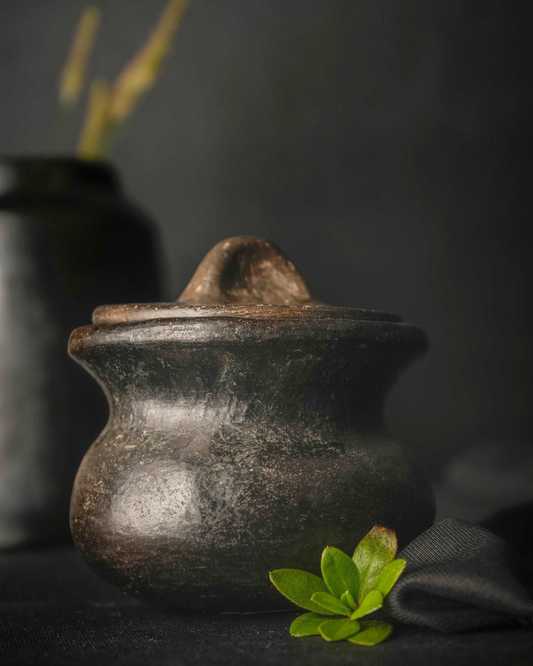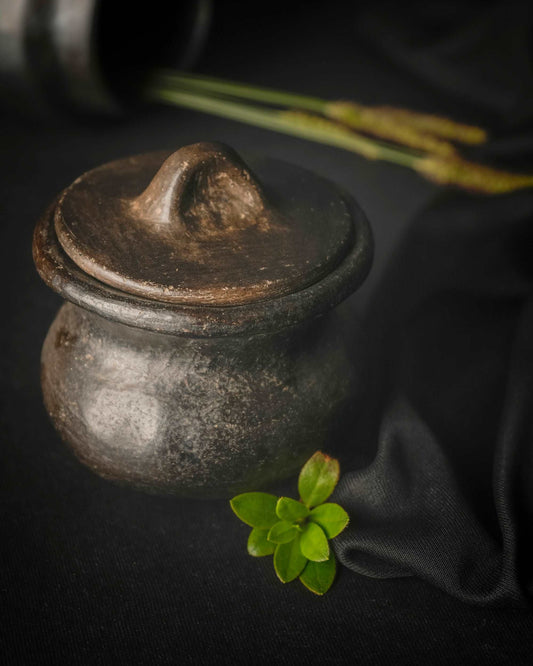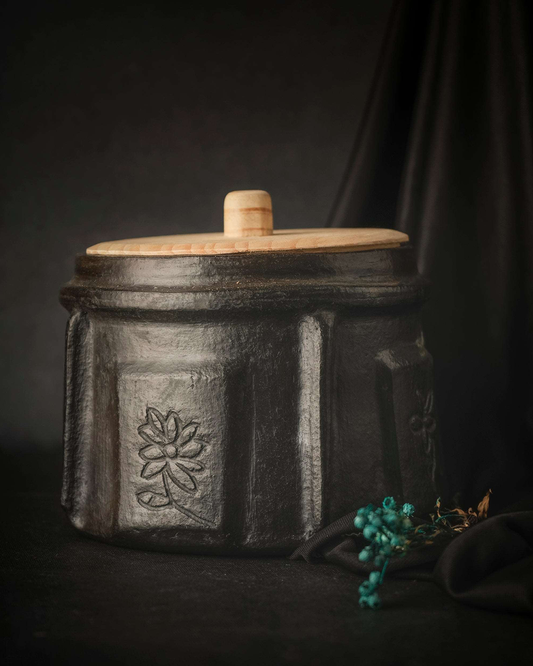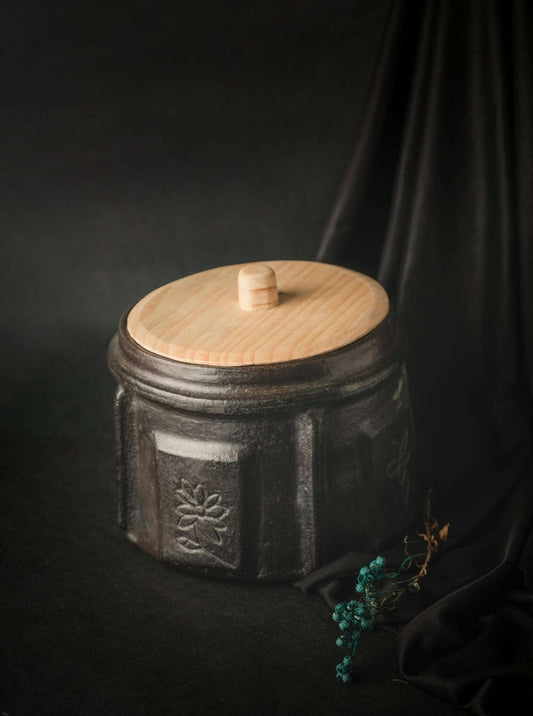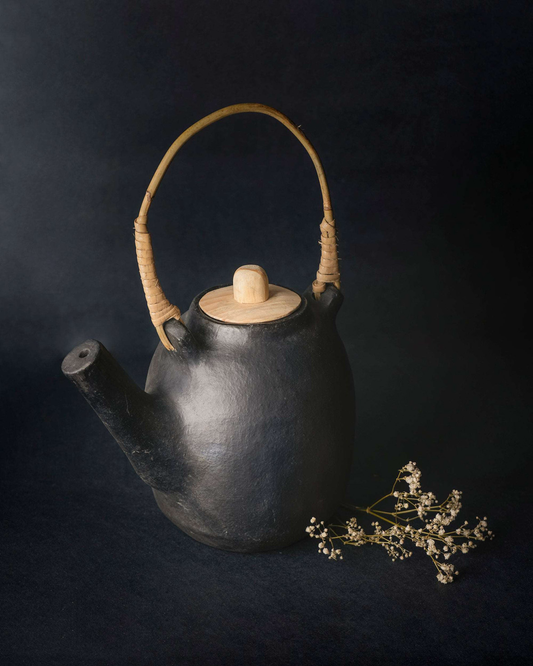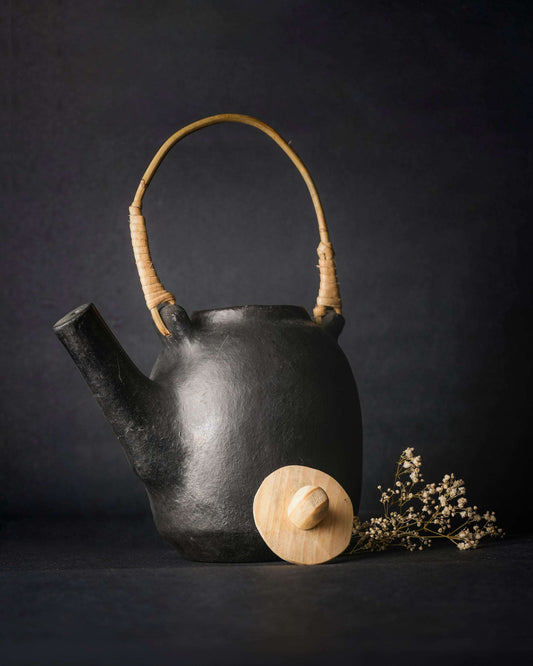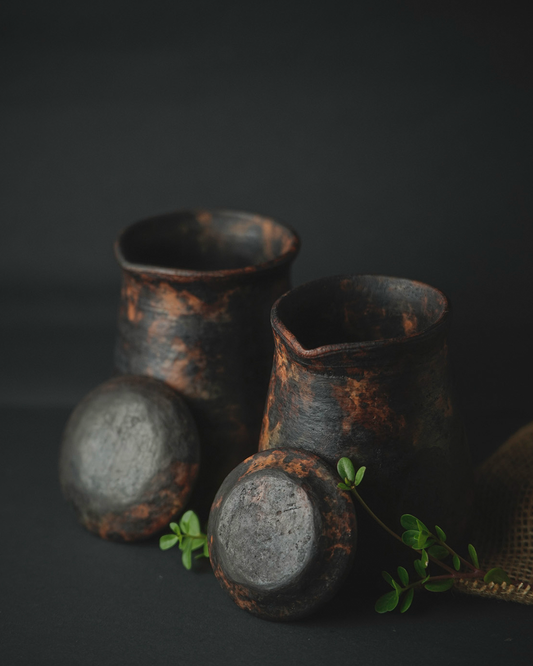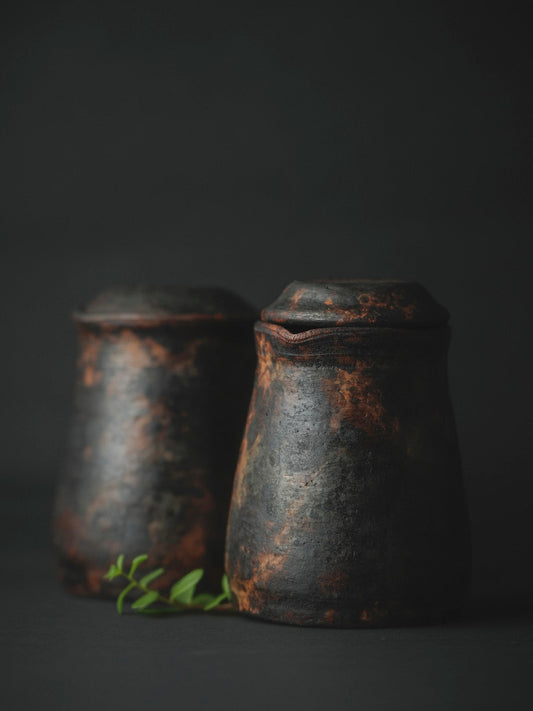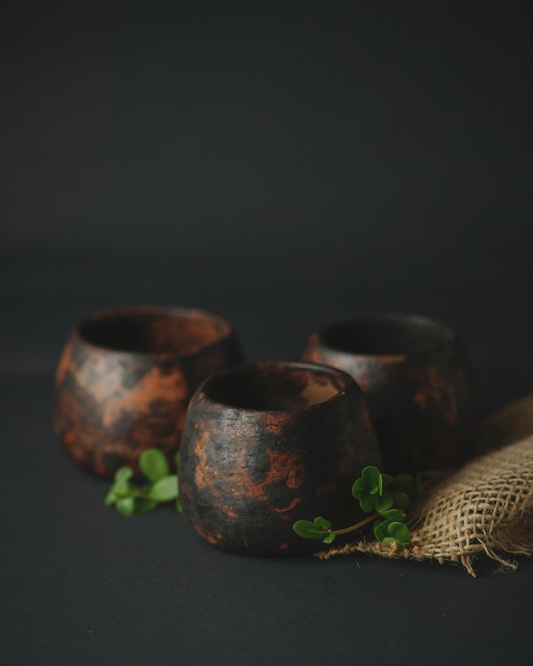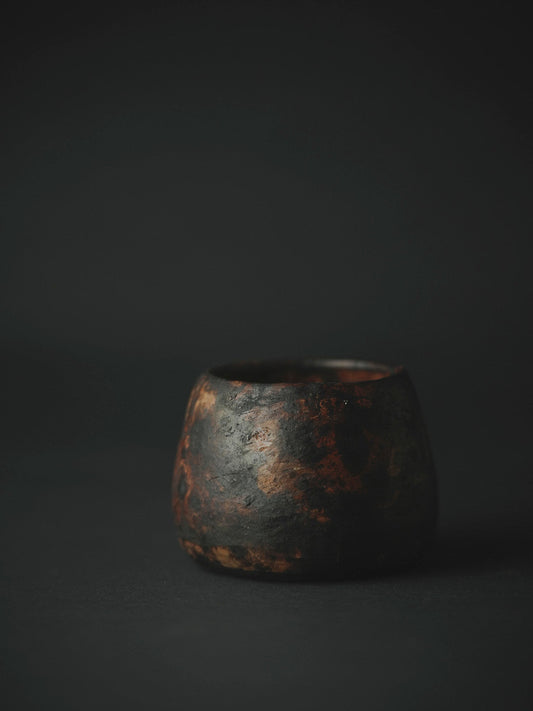संग्रह: मेघालय ब्लैक पॉटरी
At Punarnawa, we collaborate with indigenous potters from the Northeast region, specifically from Meghalaya to Manipur.
In Meghalaya, we are involved in an intriguing black pottery craft that utilizes two types of clay for creating earthenware. The clay, known as alluvial clay, is sourced from the alluvial region of the Sung Valley in the West Jaintia Hills. The first type of clay is called Silt pottery clay or red clay, and the second is black clay. Another distinctive element used in making black pottery is the black serpentine stone, which is exclusively found in the Sung Valley. It is crushed and sieved into a fine powder. The potters use firewood for an open-air firing process, ensuring that the clay pottery becomes strong and firm without any breakage.
The difference from Manipur pottery lies in the technique, hand-molding process, and clay preparation and firing, each of which varies. However, the quintessential difference In Meghalayan pottery is that potters use the bark of a tree known as the 'Sohlia' tree, scientifically called Myrica nagi tree. The bark is crushed and mixed with cold water to create a milky solution. This solution serves as a natural dye for the pottery. The hot sintered clay pottery is dipped into this milky solution, instantly turning it into a permanent black color, giving it a fossil effect. This method of dyeing the pottery is unparalleled and is a cold process of dyeing clay pottery.
Moving further up to Manipur, we work with three different tribes and their pottery.
Andro Pottery, Thangjao Pottery and Hampai Pottery popularly known as Longpi pottery.
Amid historical upheaval, a small group of Meiteis in the Imphal valley bravely clung to their indigenous Sanamahi faith, even as societal pressure mounted to convert to Hinduism from the 1700s onwards. Among them, the women practised Charai Taba, a sacred art known only to the married.
Charai Taba, or "looping clay" in translation, is a rare form of coil pottery that utilizes stacked coils and slabs to shape its forms. Its defining feature lies in the natural fossil-like imprints that harken back to ancient times.
Yet, the beauty of Charai Taba is not just in its craftsmanship, but in the resilience of its practitioners. These guardians of the past, who uphold the ancient Sanamahi faith, rely on the support to maintain their traditional wood-burning kilns and continue their craft, preserving their heritage for generations to come.
The story of Charai Taba embodies the spirit of resilience and courage, representing the last vestige of Asia's oldest matrilineal society. As part of the Andro tradition, our earthenware line pays homage to this rich legacy, ensuring quality and authenticity with every piece. Their beautiful pottery captures the delicate botanical nature of flora and fauna.
The potters of Thongjao mostly belong to the Chakpa clan, but other castes have also taken up this occupation. The raw materials for making earthen vessels are gathered from a nearby pond located to the northeast of the manufacturing workshop. The pond is dug to a depth of about seven meters to obtain the clays. The potters use a mixture of leimu (black) and leikok (whitish) clay, with 50% of each, and nungjreng (sand) as the tempering material. Similar to other pottery-making indigenous methods, they use the free hand pottery building method, where a solid lump of clay is shaped by modeling and by piece building, such as adding coils, strips, and slabs. They are known for making large vessels and pots, especially those used for local beverage making. Pottery firing at Thongjao is conducted in two stages. Initially, biscuit firing is done on a bamboo platform, and then the pots are moved to a proper kiln for proper firing. The kiln at Thongjao is made of bamboo posts and is open on all sides. In the first stage of pottery firing, the pots are placed on top of the bamboo platform, beneath which some straw and a few small wood logs are ignited and consistently stirred with a long bamboo stick. Later, more fuel is added to provide uniform heat to all the pots and control the firing process. The pots are only processed for further firing when the potter is satisfied with their appearance. The final stage of pottery firing involves shifting the pots to a kiln, where a platform of straw is made, followed by a layer of rice husk and another layer of straw. The pots are arranged tightly and covered with straw and ash. Fire is ignited from the base and left for almost 2 days. When there is no more smoke in the kiln, the pots are carefully removed with tongs and sometimes sprinkled with a solution made from kuhi (Pasania pachyphyla) bark to give them strength and color. This solution is made by soaking the bark of the kuhi in water for almost five days and is applied using a brush made of reed. Isn’t this interesting?
Stoneware Black Pottery
Stoneware black pottery is a traditional craft celebrated for its dark hue and durability. Crafted from stoneware clay renowned for its strength, these pieces are fired at high temperatures in a reducing atmosphere, resulting in their distinctive black colour.
Stoneware black pottery is a revered traditional craft known for its rich dark color and exceptional durability. Crafted from stoneware clay prized for its strength, these pieces undergo high-temperature firing in a reducing atmosphere, resulting in their unique black hue.
Beyond the aesthetic appeal of Manipur's Longpi pottery, stoneware black pottery offers functionality through its distinctive techniques and designs, while also preserving cultural heritage. From cooking pots to serving bowls, vases, and decorative pieces, these creations serve a variety of purposes. Stoneware black pottery stands out as one of the strongest and most durable stoneware pottery options, making it ideal for slow cooking.
The creation of Manipuri black stone pottery begins with serpentinite and weathered rocks, which are hand-pounded and powdered using bamboo. The powders are then mixed with water and kneaded for 7-8 hours to form a dough. This clay is then flattened using a bamboo rolling pin on a slab, with artisans shaping the pots by hand. After drying naturally for a few days, the pots are fired at temperatures ranging from 900-1200 degrees Celsius, depending on their intended use. They are then polished with chiro-na leaves and finished with beeswax, a process that takes 8-10 days.
Stoneware black pottery offers numerous benefits, including being a natural source of valuable minerals such as iron and magnesium. The pottery's unique properties also prevent harmful germs from surviving in cooked food, enhancing the taste of dishes prepared in them. These pots are ideal for simmering and slow cooking over a low flame, allowing for the homogenization and condensation of food. Additionally, the pottery's ability to retain heat ensures that food remains warm for hours after cooking, making it a valuable insulator due to serpentinite's heat-resistant properties.
Local residents who use these pottery items claim that cooking food in them can help prevent morning sickness in pregnant women. Despite being made of stone, they are lightweight and easy to handle, making them ideal for cooking and storing food. The versions without cane handles are suitable for use in OTG and microwave ovens. At Punarnawa, we are pleased to accommodate custom bulk orders.
-
लोंगपी ब्लैक पॉटरी स्टोनवेयर टी बैग पॉट
नियमित रूप से मूल्य Rs. 1,500.00 INRनियमित रूप से मूल्ययूनिट मूल्य / प्रति -
लोंगपी ब्लैक पॉटरी स्टोनवेयर मल्टी यूटिलिटी जार
नियमित रूप से मूल्य Rs. 4,000.00 INRनियमित रूप से मूल्ययूनिट मूल्य / प्रति -
लोंगपी ब्लैक पॉटरी स्टोनवेयर लंबी केतली- 1.3L
नियमित रूप से मूल्य Rs. 2,800.00 INRनियमित रूप से मूल्ययूनिट मूल्य / प्रति -
हम्पाई स्टोनवेयर ब्लैक पॉटरी
नियमित रूप से मूल्य Rs. 0.00 INRनियमित रूप से मूल्ययूनिट मूल्य / प्रति -
काले मिट्टी के बर्तनों का जग
नियमित रूप से मूल्य Rs. 1,200.00 INRनियमित रूप से मूल्ययूनिट मूल्य / प्रति -
ब्लैक पॉटरी फॉसिल टी कप
नियमित रूप से मूल्य Rs. 500.00 INRनियमित रूप से मूल्ययूनिट मूल्य / प्रति
हमारे ईमेल की सदस्यता लें
अंदरूनी ख़बरों, उत्पाद लॉन्च और बहुत कुछ के लिए हमारी मेलिंग सूची की सदस्यता लें।
